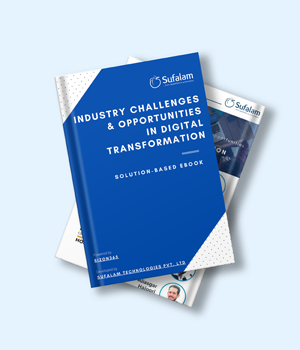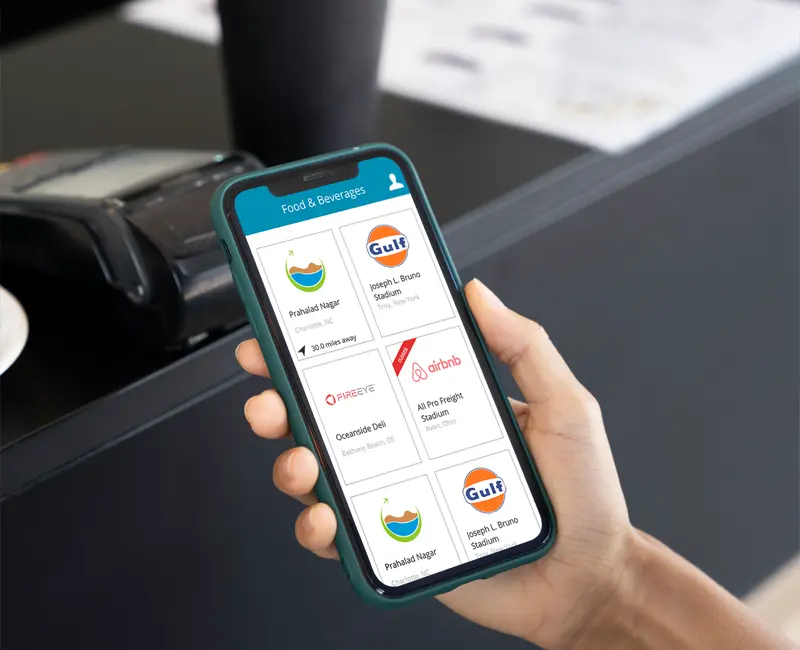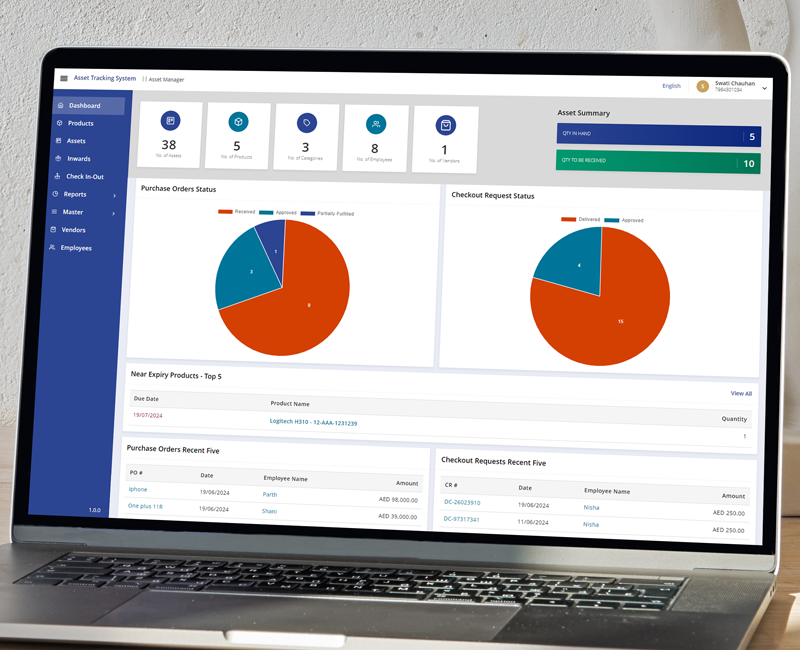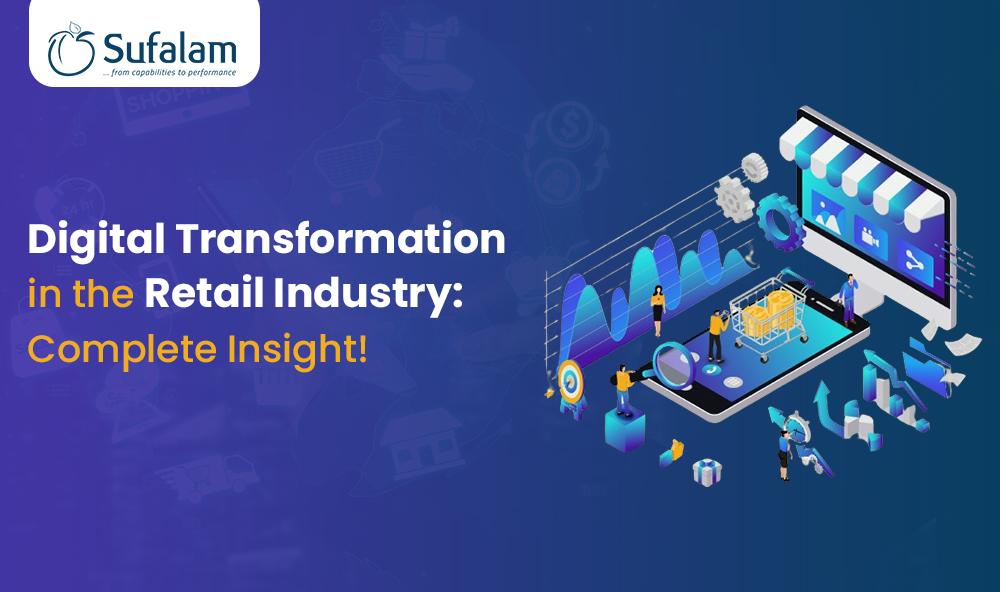
The retail sector is vast and dynamic, with trends frequently emerging and disappearing seemingly overnight. It can be challenging to keep up, but it doesn't have to be! As we look ahead to 2024, retail organizations should be aware of the significant themes that are expected to drive industry growth in the years ahead.
Given that digital transformation in the retail industry is urgently needed, retail executives are already making an effort with it. As per the most recent research conducted by Gartner, by 2023, over 50% of consumer spending will take place online, with over 60% of that being done through mobile devices
Only those retailers who embrace the digital revolution will thrive and prosper.
As digital transformation in retail will help in growth, you need to be aware of all the specifics you need to get there. To learn more about the advantages, retail trends, and challenges, this blog is all you need.
Let’s dig in!
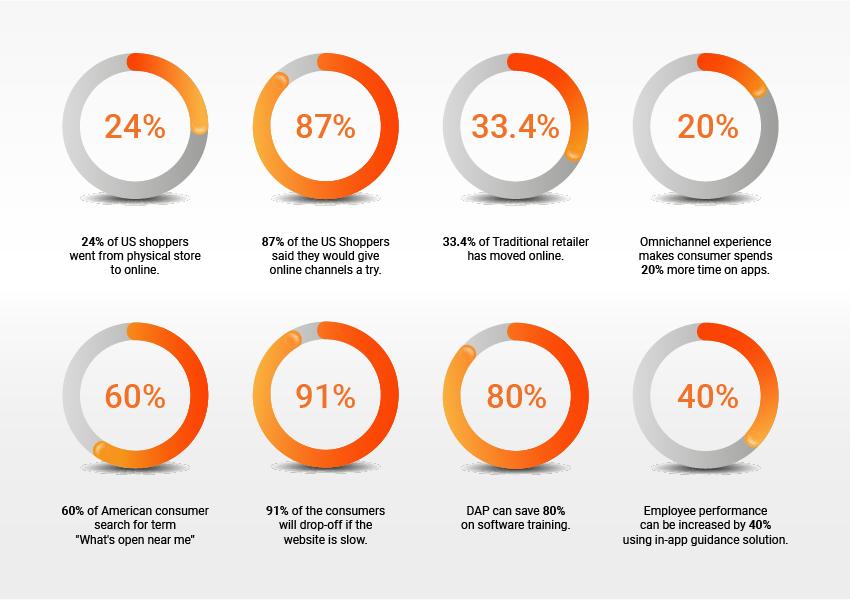
Source: hubspot
What is retail digital transformation?
Retail digital transformation is the use of technology to increase operational effectiveness, enhance the customer experience, and drive development in the retail industry.
A variety of reasons have transformed the retail business, including the growth of e-commerce and omnichannel, shifting customer behavior and hyper-individualization, and increasing the complexity of supply chains.
The digital transformation of retail encompasses several initiatives like AI-driven product suggestions, curbside pickup, self-checkout systems, contactless ordering, and cost optimization.
Furthermore, technology will play a major role in the expansion of next-generation retail, supporting smart offers, multichannel customer experiences, lean operations, and new business models. In summary, a well-thought-out and ambitious digital transition can yield a broad range of effects for retail businesses throughout.
Benefits of digital transformation in the retail industry!
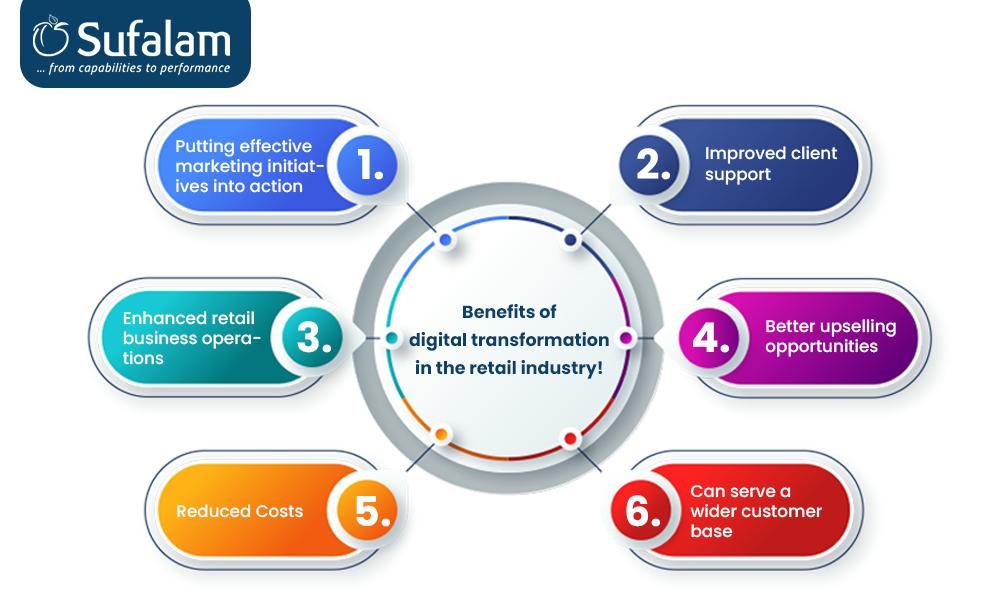
Putting effective marketing initiatives into action
Retailers can use technologies like CRM, data analytics, and marketing automation to gather customer data through digital transformation in retail and use it to develop customized and focused marketing campaigns.
Retailers can use it to gain insights into their target consumers and spot patterns and trends. Having access to this data lowers the price of marketing initiatives and aids in adjusting campaigns to reflect shifting consumer preferences.
Improved client support
Retailers may offer their customers an omnichannel experience by utilizing digital technology. It enables them to get assistance and support via email, live chat, mobile apps, and websites. Customers can self-serve by submitting their questions and complaints to the chatbot through digital transformation, which enables 24/7 real-time tailored customer support.
With the help of this technology, customers may navigate the customer journey with the fewest possible encounters, saving retailers money.
Enhanced retail business operations
Retailers may improve operations and cut labor expenses by automating procedures with the aid of AI-powered technologies like robotic process automation (RPA). Additionally, automation makes it possible to respond to consumer complaints and inquiries more quickly.
Businesses can benefit from digital transformation in the retail industry by optimizing internal operations within storefronts. For example, store workers can track inventory levels in real-time without requiring them to manually count items every day thanks to radio-frequency identification tags affixed to products. In the same way, automated checkout systems shorten customer lines and raise consumer satisfaction levels.
Better upselling opportunities
Upselling continues to be one of the key advantages of the digital transformation of retail since it's a quick and simple approach to increasing sales. Digital tools allow you to boost revenue with almost no additional effort.
Let's take an example where a customer has anything in their cart. In such instances, you can do what you frequently see on Amazon: show "similar" or "recommended" products that are complimentary to that one.
Upselling can boost sales by 10% to 30%, according to data. Furthermore, this strategy is 68% less expensive than bringing on a new client. The Internet of Things (IoT) and application programming interfaces (APIs) have made it easier to take advantage of upselling and cross-selling possibilities.
Reduced Costs
In the retail industry, deploying digital technologies can improve accuracy while lowering overhead expenses related to manual processes like inventory management or order processing.
Furthermore, scalability is provided by cloud computing services without the need for further hardware purchases, which eventually contributes to a substantial decrease in IT costs and other operational costs as well.
So, with the right technologies, abiding by the best practices for digital transformation, and partnering with leading digital transformation company in the retail industry, retail businesses can reduce costs significantly while also boosting customer satisfaction and sales ultimately.
Can serve a wider customer base
Since 76% of adult Americans shop online, you are no longer restricted to local customers and physical stores. Being a technologically savvy company allows you to take advantage of these customers and reach a wider audience. Customers may reach your store via mobile devices from anywhere, so make use of that platform.
With services like in-store pickup, online buying, fulfilling through delivery partners, tailored recommendations, and much more, you may be more accessible than ever thanks to APIs.
Digital transformation trends in the retail industry!
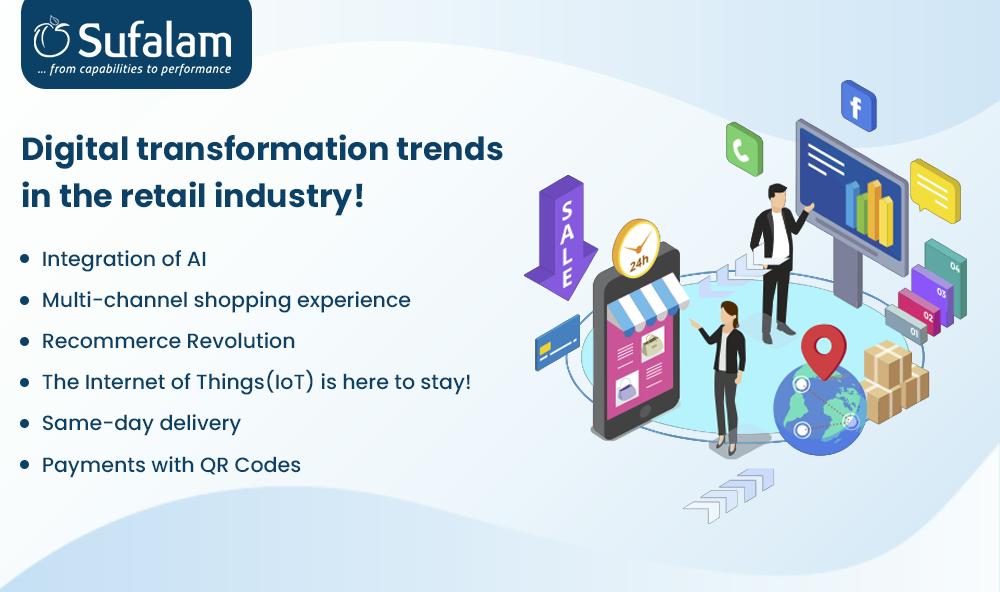
Integration of AI
This revolutionary change is centered on the smooth integration of AI-powered customer engagement technologies. Advanced artificial intelligence (AI) solutions will bring in a new era of dynamic interactions with real-time insights, personalized product recommendations, and quick answers to questions.
Accenture reports that 64% of customers want businesses to react more quickly, something that merchants can now achieve. More companies will use AI to improve the customer experience in general, addressing issues, fostering loyalty, and offering tailored support all along the way—from order monitoring to easy returns.
AI-powered customer interaction solutions will also aid in the management and collection of user data. This vast amount of information will help with product improvement and enable merchants to improve their offerings and focus their marketing efforts.
Multi-channel shopping experience
One buying trend that is making a comeback is in-person shopping.
Given that returns account for 16.5% of purchases made in the United States, a substantial shift is anticipated.
With 40% of worldwide customers already indicating their intention to boost in-person buying, it is anticipated that more consumers will shift from making purchases online to making in-store purchases.
Big box retailers will adopt a multichannel strategy in response, promoting the in-person experience. These retailers will encourage customers to pick up their online items in-store, increasing foot traffic and creating a better shopping experience, even if they will still have an online presence.
Even while e-commerce continues to dominate the market, providing distinctive in-store services and incentives that go beyond standard shopping will help draw people back to physical locations.
Recommerce Revolution
It is a new trend, that has been growing in popularity for some time now. It is among the exciting trends that will witness further growth in 2024 as well.
Concerns about environmental sustainability are driving the e-commerce revolution, with the resale of secondhand products becoming more common. Several retailers, such as ThredUP and The RealReal, are capitalizing on this trend by providing a platform for people to buy and sell pre-owned things.
It is anticipated that the trend toward more environmentally friendly shopping habits will only pick more steam. This trend has been on the rise as a result of the increasing shift in customer awareness that has resulted from these variables.
The Internet of Things(IoT) is here to stay!
In the retail industry, the Internet of Things has altered how products are tracked throughout the supply chain. GPS and RFID technology have transformed the retail industry.
The Internet of Things has also had a part in reducing shoplifting through the use of geofencing. Every day, more than $25 million in merchandise is stolen from retail stores, according to the National Association for Shoplifting Prevention (NASP).
RFID tags enable store operators to build a virtual barrier around retail premises, which aids in theft control and leads to more efficient retail operations.
Same-day delivery
Same-day delivery is no longer unusual in the retail sector, as customer expectations rise. To meet this demand, retailers are under pressure to simplify their fulfillment procedures. With their Prime shipping service, companies like Amazon have set the bar high and encouraged other shops to follow. This unique product helps merchants stand out from the competition and carve out a position for themselves in this cutthroat market.
Payments with QR Codes
Another noteworthy trend is the growing use of QR codes for payments. This easy and convenient contactless payment option has gained a lot of traction and is predicted to continue to grow in popularity throughout the world. It provides retailers with a streamlined payment procedure and gives customers a quick and simple option to pay.
Challenges of digital transformation in the retail sector!
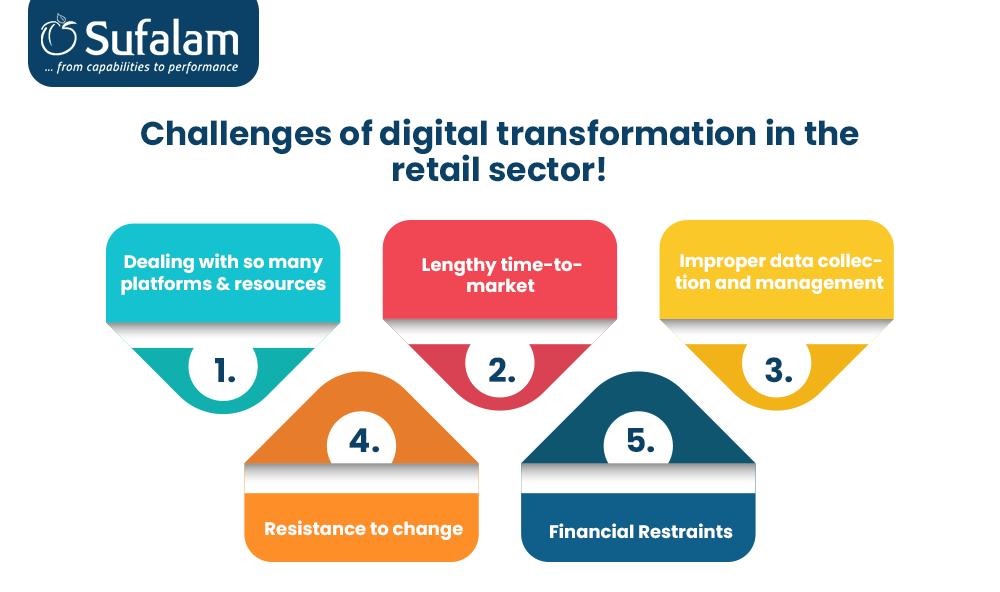
Dealing with so many platforms & resources
With the need to sell products across so many platforms, merchants confront an ever-increasing demand for compelling and targeted content to catch the attention of their target audience - all while working with limited marketing resources.
Lengthy time-to-market
Retailers must continually produce novel and inventive products to maintain their competitiveness. However, the time and resources required for traditional product design procedures, which involve multiple iterations, physical prototypes, and intricate development cycles, can be rather high.
Not to mention giving the go-ahead for all the materials used to market the goods. It can result in missed chances, delayed product launches, and, eventually, an unfair advantage.
Improper data collection and management
Consumers want a fantastic, personalized experience when they purchase, and it can be difficult for businesses to properly manage their databases to get insightful data from their clients and provide the greatest possible experiences.
While gathering a lot of data is crucial, figuring out how to track, evaluate, and organize the information obtained from each contact becomes increasingly difficult. Customers may be misled and have a bad experience due to inaccurate or ineffective data handling.
Resistance to change
Resistance to change from departments and individuals accustomed to handling their touchpoints in particular ways can coexist with digital transformation in the retail industry.
In the context of successful digital transformation, it might be risky to adopt a mindset that only questions or alters once there is a crisis. People usually become aware of the rapidly shifting market environment after it is too late.
Financial Restraints
Financial resources are strained as retailers prepare for modernization through digital transformation.
For many retailers, digital transformation ends with the development of a mobile app or website. Retailers should consider the whole picture, which includes AI-powered bots, AR/VR choices, headless commerce, mobile point of sale, etc., to benefit fully from digital transformation. These possibilities come at a significant expense.
Bottom Line
In conclusion, the digital transformation in the retail industry is not merely a passing trend; it has become a fundamental force reshaping the landscape of commerce. The rising demand for seamless, personalized experiences, coupled with the relentless pace of technological innovation, has propelled retailers into a new era of business.
The benefits of digital transformation in the retail sector are substantial and multifaceted. And, the ability to adapt to changing consumer expectations and market dynamics has positioned digitally transformed retailers as leaders in a fiercely competitive landscape.
Continuous innovation, agility, and a customer-centric mindset will be the driving forces propelling retailers toward sustained success. Those who embrace and leverage digital advancements will not only survive but thrive in an era where adaptability is synonymous with longevity.
If you are looking for a reliable partner to help you tap into the benefits of digital transformation in retail, then Sufalam Technologies has got you covered. Our mobile app development company is compliant with the latest trends and market preferences to help you effectively leverage the benefits and skyrocket your retail business.
Frequently Asked Questions
Why is the digital transformation needed in the retail industry?
Digital transformation in retail enhances customer experience, optimizes operations, enables data-driven decision-making, improves inventory management, and adapts to evolving consumer preferences, fostering competitiveness and growth.
Which are the leading retail companies leveraging digital transformation?
Companies like Amazon, Walmart, Alibaba, and Target are leading the way in digital transformation in retail.

